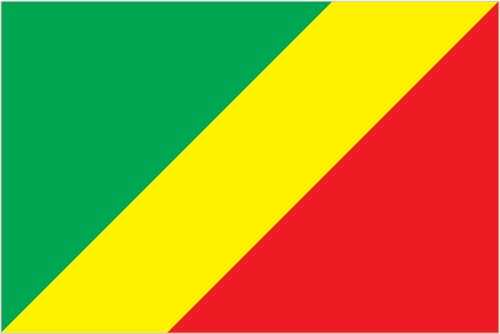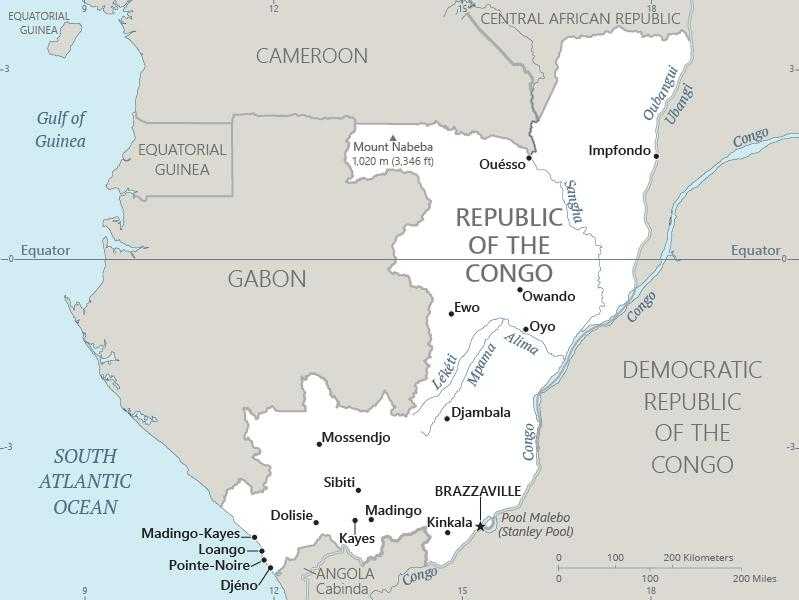Introduction
Background
Upon independence in 1960, the former French region of Middle Congo became the Republic of the Congo. A quarter-century of experimentation with Marxism was abandoned in 1990 and a democratically elected government took office in 1992. The Republic of Congo is one of Africa's largest petroleum producers.
Geography
Area
total: 342,000 sq km
land: 341,500 sq km
water: 500 sq km
Climate
tropical; rainy season (March to June); dry season (June to October); persistent high temperatures and humidity; particularly enervating climate astride the Equator
Natural resources
petroleum, timber, potash, lead, zinc, uranium, copper, phosphates, gold, magnesium, natural gas, hydropower
People and Society
Population
total: 6,097,665
male: 3,045,973
female: 3,051,692 (2024 est.)
Ethnic groups
Kongo (Bakongo) 40.5%, Teke 16.9%, Mbochi 13.1%, foreigner 8.2%, Sangha 5.6%, Mbere/Mbeti/Kele 4.4%, Punu 4.3%, Pygmy 1.6%, Oubanguiens 1.6%, Duma 1.5%, Makaa 1.3%, other and unspecified 1% (2014-15 est.)
Languages
French (official), French Lingala and Monokutuba (lingua franca trade languages), many local languages and dialects (of which Kikongo is the most widespread)
Religions
Roman Catholic 33.1%, Awakening Churches/Christian Revival 22.3%, Protestant 19.9%, Salutiste 2.2%, Muslim 1.6%, Kimbanguiste 1.5%, other 8.1%, none 11.3% (2007 est.)
Population growth rate
2.38% (2024 est.)
Government
Government type
presidential republic
Capital
name: Brazzaville
Executive branch
chief of state: President Denis SASSOU-Nguesso (since 1997)
head of government: Prime Anatole Collinet MAKOSSO (since 12 May 2021)
Legislative branch
description: bicameral Parliament or Parliament consists of:
Senate (72 seats; members indirectly elected by local, district, and regional councils by simple majority vote to serve 6-year terms) note- the Senate is renewed in its entirety following a constitutional reform implemented in 2015 ending the renewal by half
National Assembly (151 seats; members directly elected in single-seat constituencies by absolute majority popular vote in 2 rounds if needed; members serve 5-year terms)
Economy
Economic overview
primarily an oil- and natural resources-based economy; recovery from mid-2010s oil devaluation has been slow and curtailed by COVID-19; extreme poverty increasing, particularly in southern rural regions; attempting to implement recommended CEMAC reforms; increasing likelihood of debt default
Real GDP (purchasing power parity)
$21.913 billion (2022 est.)
$21.594 billion (2021 est.)
$21.377 billion (2020 est.)
Real GDP per capita
$3,700 (2022 est.)
$3,700 (2021 est.)
$3,700 (2020 est.)
Agricultural products
cassava, sugarcane, oil palm fruit, bananas, plantains, root vegetables, game meat, vegetables, mangoes/guavas, fruits (2022)
Industries
petroleum extraction, cement, lumber, brewing, sugar, palm oil, soap, flour, cigarettes
Exports
$4.67 billion (2020 est.)
$7.855 billion (2019 est.)
$4.6 billion (2016 est.)
Exports - partners
China 39%, India 20%, UAE 15%, Italy 5%, Vietnam 4% (2022)
Exports - commodities
crude petroleum, refined copper, wood, tin ores, rare earth ores (2022)
Imports
$3.279 billion (2020 est.)
$4.945 billion (2019 est.)
$7,291,015,964 (2016 est.)
Imports - partners
China 26%, France 9%, UAE 6%, Belgium 6%, India 5% (2022)
Imports - commodities
poultry, garments, vaccines, ships, fish (2022)
Exchange rates
Cooperation Financiere en Afrique Centrale francs (XAF) per US dollar -
Exchange rates:
623.76 (2022 est.)
554.531 (2021 est.)
575.586 (2020 est.)
585.911 (2019 est.)
555.446 (2018 est.)
Page last updated: Saturday, May 25, 2024




